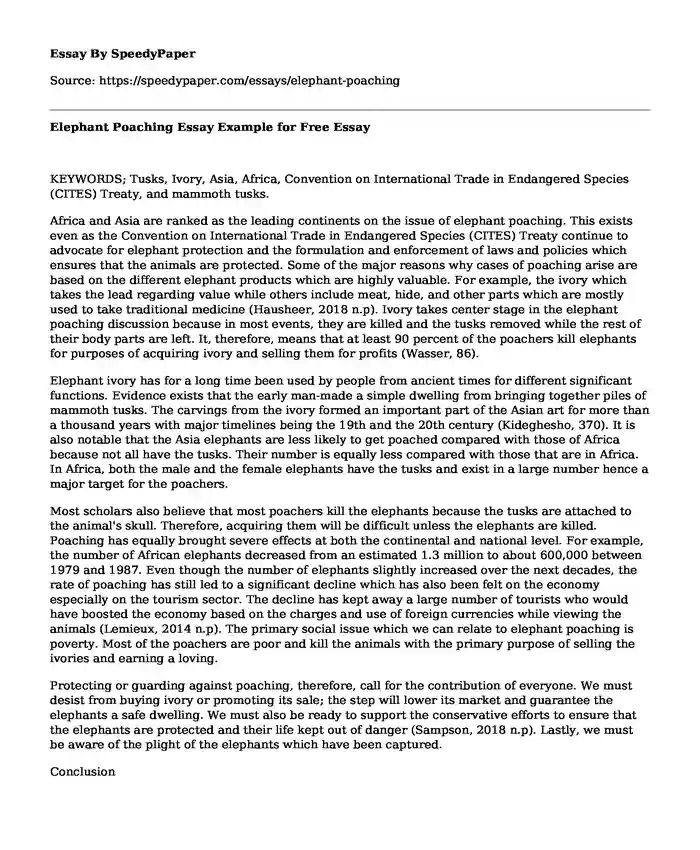KEYWORDS; Tusks, Ivory, Asia, Africa, Convention on International Trade in Endangered Species (CITES) Treaty, and mammoth tusks.
Africa and Asia are ranked as the leading continents on the issue of elephant poaching. This exists even as the Convention on International Trade in Endangered Species (CITES) Treaty continue to advocate for elephant protection and the formulation and enforcement of laws and policies which ensures that the animals are protected. Some of the major reasons why cases of poaching arise are based on the different elephant products which are highly valuable. For example, the ivory which takes the lead regarding value while others include meat, hide, and other parts which are mostly used to take traditional medicine (Hausheer, 2018 n.p). Ivory takes center stage in the elephant poaching discussion because in most events, they are killed and the tusks removed while the rest of their body parts are left. It, therefore, means that at least 90 percent of the poachers kill elephants for purposes of acquiring ivory and selling them for profits (Wasser, 86).
Elephant ivory has for a long time been used by people from ancient times for different significant functions. Evidence exists that the early man-made a simple dwelling from bringing together piles of mammoth tusks. The carvings from the ivory formed an important part of the Asian art for more than a thousand years with major timelines being the 19th and the 20th century (Kideghesho, 370). It is also notable that the Asia elephants are less likely to get poached compared with those of Africa because not all have the tusks. Their number is equally less compared with those that are in Africa. In Africa, both the male and the female elephants have the tusks and exist in a large number hence a major target for the poachers.
Most scholars also believe that most poachers kill the elephants because the tusks are attached to the animal's skull. Therefore, acquiring them will be difficult unless the elephants are killed. Poaching has equally brought severe effects at both the continental and national level. For example, the number of African elephants decreased from an estimated 1.3 million to about 600,000 between 1979 and 1987. Even though the number of elephants slightly increased over the next decades, the rate of poaching has still led to a significant decline which has also been felt on the economy especially on the tourism sector. The decline has kept away a large number of tourists who would have boosted the economy based on the charges and use of foreign currencies while viewing the animals (Lemieux, 2014 n.p). The primary social issue which we can relate to elephant poaching is poverty. Most of the poachers are poor and kill the animals with the primary purpose of selling the ivories and earning a loving.
Protecting or guarding against poaching, therefore, call for the contribution of everyone. We must desist from buying ivory or promoting its sale; the step will lower its market and guarantee the elephants a safe dwelling. We must also be ready to support the conservative efforts to ensure that the elephants are protected and their life kept out of danger (Sampson, 2018 n.p). Lastly, we must be aware of the plight of the elephants which have been captured.
Conclusion
The research has focused on two continents, Asia and Africa. Elephant poaching is however prevalent in the former than the latter. The reason is based on most elephants in Asia lacking the tusks as opposed to Africa. The last issue which has been discussed in the research has been noted on the effects of poaching as noted herein.
Works Cited
Hausheer, Justine E. "Poachers Are Killing Asian Elephants for Their Skin." Nature (2018).
Kideghesho, Jafari R. "The Elephant poaching crisis in Tanzania: a need to reverse the trend and the way forward." (2016): 369-388.
Lemieux, Andrew M., ed. Situational prevention of poaching. Routledge, 2014.
Sampson, Christie, et al. "New elephant crisis in Asia-early warning signs from Myanmar." PloS one 13.3 (2018): e0194113.
Wasser, Samuel K., et al. "Genetic assignment of large seizures of elephant ivory reveals Africa's major poaching hotspots." Science 349.6243 (2015): 84-87.
Cite this page
Elephant Poaching Essay Example for Free. (2022, Nov 07). Retrieved from https://speedypaper.com/essays/elephant-poaching
Request Removal
If you are the original author of this essay and no longer wish to have it published on the SpeedyPaper website, please click below to request its removal:
- Free Essay with the Research on Mental Disorders in Children Living in Urban Areas
- Professional Conduct on Social Media
- Free Essay Sample on Car Wars at Wolfsburg
- Free Essay: Balance between Global and Domestic Determinants of Economy and Policy
- Free Essay: Alternate Ending of The Great Gatsby Novel
- Herodotus and Condorcet's Perceptions of the Purpose of History - Essay Sample
- Essay Sample on Database, BI, the Internet, and Wireless Technology
Popular categories





